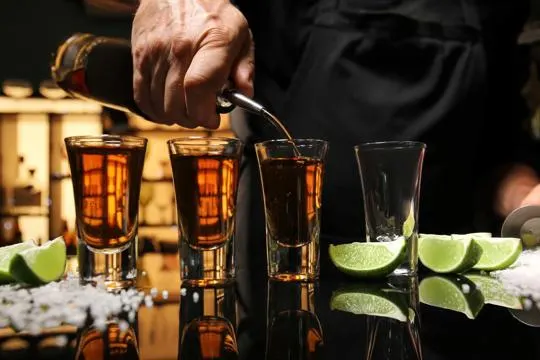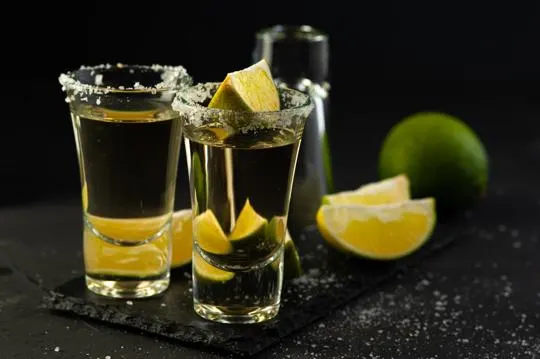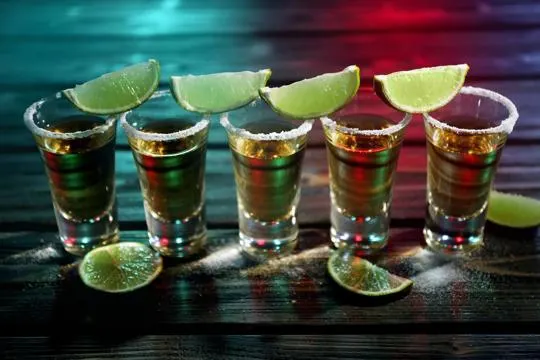Summary of key points
The main difference between dark and light tequila lies in the aging process. Dark tequila, also known as “anejo,” is aged for at least one year in oak barrels, resulting in a smoother, more complex taste. Light tequila, or “blanco,” is bottled immediately after distillation and has a sharper, more agave-forward flavor. Both are delicious options for sipping or mixing in cocktails, so it ultimately comes down to personal preference and what you’re in the mood for. Whichever one you choose, be sure to savor every sip of this beloved Mexican spirit!
Tequila! Ah, the spirit that has fueled many a party and, occasionally, regret. Did you know there’s a whole saga between dark and light tequila? It’s not just about the color.
Dark tequila boasts aging in barrels, giving it that rich, complex flavor we often brag about over fancy dinners. Light tequila, on the flip side, is the young wild child, mostly unaged and ready to kick the party into high gear.
We’ve all had those nights, mixing them up, then trying to piece together the memories the next morning.
In our quest, we discovered that the difference isn’t just in hangover potential. It’s in the taste, the smoothness, and how you’ll probably want to drink it.
Ready to dive in and find out why your Margarita tastes so divine… or doesn’t?
What is Dark Tequila?

Dark tequila is a unique type of tequila.
It undergoes a longer aging process in oak barrels.
This gives it a rich, amber color and bold flavor.
Notes of caramel and vanilla develop during the aging process.
The extended maturation period produces a smoother finish.
Dark tequila is a popular choice for sipping straight or in cocktails.
Its complexity and depth make it an excellent choice for those seeking a more robust tequila experience.
What is Light Tequila?

Light tequila – a unique spirit.
It has a shorter aging process than its darker counterpart.
The result? A crystal clear, vibrant flavor with hints of citrus and agave.
It’s also great for cocktails – its fresh taste really stands out.
And the production process? After being distilled from blue agave plants, it goes through a brief “reposado” or “rested” period in wooden barrels or stainless steel tanks.
Light tequila’s versatility is perfect for mixology.
Mix it with lime juice, mint, pineapple, or mango for a zesty twist.
Plus, you can enjoy it neat.
This light and refreshing spirit brings brightness and zest to every sip.
So, if you’re seeking a lighter yet flavorful option, look no further than light tequila.
Differences Between Dark and Light Tequila

Tequila comes in two varieties: dark and light.
They differ not just in looks, but also in taste and production process.
Aging Process
Aging tequila is a critical factor that sets dark tequila apart from light.
It’s the maturation in barrels which contribute color, flavor, and aroma.
Dark tequila ages longer than light, bringing out richer, more complex tastes.
Dark tequila is usually aged in oak barrels for a minimum of one year.
This extended aging allows deeper flavors to develop, as well as a darker hue.
The wood of the barrels adds notes of vanilla, caramel, and spices, making it more complex.
Light tequila, however, goes through shorter aging or none at all.
Usually, it is stored in stainless steel tanks or bottled right after distillation.
This keeps its clear appearance and allows its natural flavors to stand out without the barrel’s influence.
Aside from color and flavor, aging affects the tequila’s character too.
Dark tequila is smoother and silkier because of its longer interaction with wood.
Light tequila, on the other hand, is crisper and has fresher agave notes.
In summary, understanding how aging works helps us appreciate dark and light tequila’s contrast.
Both styles offer distinct qualities – robust flavors from long maturation and bright, youthful expressions from little contact with wood.
These cater to different preferences and occasions.
Flavor Profile
Tequila has a special flavor profile.
So, what makes dark tequila different from light tequila? It’s all down to their distinct flavors and characteristics.
Dark tequila, also known as reposado or añejo, ages in oak barrels.
This gives it a richer taste with notes of caramel, vanilla, and even chocolate.
The aging process softens the agave, making it smoother.
Light tequila, aka blanco or silver tequila, is bottled straight away.
It has a fresh taste with zesty and herbal flavors, plus hints of citrus and black pepper.
It’s all about personal preference when choosing between dark and light tequila.
Dark tequila is great for sipping neat or adding to drinks like Old Fashioneds or Negronis.
Light tequila is perfect for classic margaritas or simpler mixed drinks like Palomas.
Color and Appearance
Tequila, beloved by many, often comes in two shades: dark and light.
The color and look of tequila can offer great insight into its flavor and aging process.
Dark tequila, like reposado and añejo, has spent a long time in oak barrels.
This gives it a deep amber color. Plus complex flavors and aromas.
On the other hand, light tequila (blanco or silver) is unaged or aged for only a short time.
This results in a clear or golden liquid with a crisp taste.
Other than the color, the appearance of tequila could depend on filtration techniques and bottling processes.
Some distilleries might filter it more for a smoother texture and fewer impurities.
Others might use different bottles to highlight their branding or artisanal qualities.
Uses in Cocktails
Tequila is a star in cocktails. Its versatility makes it perfect for an endless variety of flavor combos.
Prefer bold dark tequila? Or light and fruity? There’s a cocktail just for you.
Mix tequila with citrus for a tangy refresher.
Add agave syrup or orange or pineapple juice for a sweeter taste.
Margaritas are a classic, and they’re even better with different types of tequila.
For something more complex, try Palomas and Tequila Sunrises.
They use ingredients like grapefruit soda, grenadine and egg whites for layered flavors and stunning looks.
Or just enjoy tequila neat. Dark tequila has a robust flavor, while light tequila is smoother.
Enjoy the distinct qualities without any distractions.
Similarities Between Dark and Light Tequila

Dark and light tequila share the same origin story – distilled spirits made from agave plants.
Both go through fermentation and distillation to create their unique flavors and aromas.
Mexico’s government ensures quality and authenticity with regulations.
The primary difference? Their aging process.
Let’s dive deeper.
Dark tequila (añejo or reposado) spends longer in oak barrels.
This extra maturation gives the spirit a richer hue and taste.
Think notes of vanilla, caramel, and spice.
Light tequila (blanco or silver) is bottled soon after distillation, with no barrel aging.
This results in a purer agave flavor – crisp, vibrant, herbal, and citrusy.
A few tweaks to production yield vastly different results. It’s all about personal preference.
No matter which type you choose, it will offer a special exploration into Mexican culture and an enjoyable sip.
Best Ways to Enjoy Dark and Light Tequila
Dark and light tequila look similar, but have different characteristics.
Dark tequila has a bolder flavor from aged barrels in production.
Light tequila is unaged or aged for a shorter time, making it more subtle.
Sip dark tequila neat or on the rocks to savor its flavor.
Light tequila is good for cocktails due to its versatility.
Both types of tequila offer unique experiences.
Next time you pour a glass, remember there are different ways to enjoy each one.
Choosing Between Dark and Light Tequila: Factors to Consider
Choosing between dark and light tequila can be tricky.
There are many things to think about. One is the aging process.
It affects the taste and color of the tequila.
Dark tequila, also known as aged or reposado tequila, is aged in oak barrels.
This can be for two months to one year.
This gives it a smooth and mellow taste with flavors of vanilla, caramel, and spice.
It’s usually had straight or on the rocks.
Light tequila, also known as blanco or silver tequila, is unaged or aged for a short period.
This lets the natural agave flavors come through.
It usually has a crisp and vibrant taste with hints of citrus and pepper.
It’s often used in cocktails because of its clean flavor.
It really depends on personal preference when choosing between dark and light tequila.
Some people like the smoothness and depth of dark tequilas while others prefer the brightness and simplicity of light tequilas.
Either way, they both offer an enjoyable drinking experience – alone or mixed into cocktails.
Conclusion
Tequila aficionados are often in disagreement about the distinctions between dark and light tequila.
The distillation process is similar for each, but aging time and flavor profiles differ.
Añejo, the dark variety, is aged for a lengthier period in oak barrels.
This produces a smoother and more intricate taste.
Blanco, the light kind, is filled directly after distillation.
This gives it a bright and lively flavor.
Additionally, añejo has a darker hue from the aging, whereas blanco remains transparent.

Leave a comment